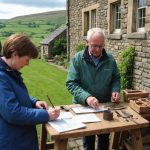Overview of British Coal Mining History
Coal mining in Britain has a profound historical significance, serving as a backbone for the Industrial Revolution. The evolution of British coal mining marked several key milestones, transforming both the industry and the economy.
The earliest coal mining dates back to Roman times, but it dramatically expanded during the 18th and 19th centuries. The Industrial Revolution was pivotal. As factories proliferated, the demand for coal surged, fueling steam engines, ironworks, and railways. This surge positioned coal mining at the heart of Britain’s economic growth.
Also read : Discovering Enchanting Guided Tours of the UK’s Medieval Cathedrals: A History Lover’s Guide
The development of large-scale coal mines began in the early 18th century, heralding a shift from small pits to expansive collieries. The invention of the steam engine by James Watt revolutionized the industry, enabling deeper exploration and extraction. By the late 19th century, Britain had become the world’s leading coal producer, with coal being central to its industrial prowess.
Significant milestones include the Mines Act of 1842, which banned women and children under ten from working underground, highlighting a shift towards safer working conditions. The nationalization of the coal industry in 1947 further reflects its transformative journey, illustrating coal’s enduring role in shaping British society and industry.
Also read : Join the Fun: A Guide to Experiencing Traditional English Cider-Making Workshops in Somerset
Top Guided Tours of British Coal Mining Sites
Embark on a journey through history with guided tours of British coal mining sites, where the industrial past comes to life. Guided tours are essential for uncovering the rich stories of these iconic locations, providing in-depth educational insights that are both fascinating and enlightening.
Visiting these coal mining sites through a guided experience often includes expert explanations of the working conditions and innovations that powered Britain’s industrial revolution. Trained guides lead the way, offering historical context and discussing the societal impacts of coal mining. This firsthand interpretation transforms static history into a dynamic narrative, allowing you to appreciate the full significance of these sites.
A well-curated tour should include:
- A detailed introduction to the mining site’s historical prominence.
- Demonstrations of the mining technology used during different periods.
- Stories of the miners and their communities.
Expect to delve into the depths of history during a typical tour, often with opportunities to explore preserved mining equipment and underground tunnels. These elements make guided tours not only educational but also captivating experiences. By participating in these tours, you support the preservation of heritage and contribute to the ongoing telling of Britain’s industrial story.
Detailed Descriptions of Notable Tours
Exploring mining history through tour descriptions can be both educational and engaging. This section details three notable mining tours, revealing not only the experiences offered but also the historical significance and unique features of each site.
Tour 1: The National Coal Mining Museum
The National Coal Mining Museum offers an immersive dive into working life in coal mines. Situated in West Yorkshire, the experience includes a guided underground tour by former miners. Participants gain insights into the daily conditions faced by miners. Notable site highlights include exhibits dedicated to mining history and machinery.
Tour 2: The Big Pit National Coal Museum
Located in Wales, the Big Pit National Coal Museum is an outstanding site for those interested in mining experiences. This tour is noted for its unique underground tour that takes attendees 300 feet below ground. Former miners lead you through historic tunnels. The museum also features interactive displays that provide a deep understanding of Welsh coal mining heritage.
Tour 3: Ecton Hill Mining Tour
The Ecton Hill Mining Tour, positioned in England’s Peak District, provides visitors with a glimpse into historical copper mining practices. Key features include impressive underground workings from the 18th century. These tour descriptions emphasize the innovative methods used in copper extraction and offer stunning site highlights worth exploring.
Key Historical Facts About Coal Mining in Britain
Coal mining has been foundational to Britain’s economic development. The economic and social impacts of coal mining were pronounced, especially during the Industrial Revolution. Mines significantly contributed to powering factories and railways in Britain’s major cities, thus accelerating urban growth. The creation of mining jobs led to the establishment of miner communities, which greatly influenced social structures and local economies.
When discussing major British coalfields, several regions stand out. The North East, Midlands, and South Wales coal fields were crucial hubs of coal extraction. This geographical distribution fostered economic prosperity in these areas, leading to their historical relevance. These regions became centers for technological advancements in mining and mechanisation, considerably reshaping the local landscapes.
The cultural heritage linked to coal mining remains visible even today. This involves preserving mining sites and creating museums dedicated to the practice, aiming to respect and remember the difficulties miners faced. The stories and struggles of miner communities continue to be an essential part of British mining heritage. These efforts ensure that future generations can learn from and appreciate the robust history of coal mining in Britain.
Visitor Information and Practical Tips
Planning visits to ensure a fulfilling experience requires careful consideration of several factors. One essential aspect is understanding tour logistics, which includes pricing and availability. Prices can vary based on the tour type and time of year, so it’s wise to verify costs in advance. Availability often fluctuates, especially during peak seasons or weekends, so booking early can be beneficial.
When considering the best times to visit, aim for weekdays or off-peak hours to avoid crowds and maximize the experience. These periods generally offer a more relaxed atmosphere, allowing for better enjoyment and more personalized interactions.
Transportation and accommodation play crucial roles in the logistics of your visit. Depending on the location, options such as public transport, rental cars, or guided shuttle services may be available. Research transportation methods that align with your itinerary and budget.
For accommodations, proximity to the site can enhance convenience, reducing travel time and letting you focus more on the tour itself. Whether you opt for nearby hotels or charming bed-and-breakfast spots, ensure they offer easy access to your desired locations.
With these visitor tips in mind, your planning can lead to more rewarding, less stressful visits.
User Reviews and Testimonials
To understand the nuances and benefits of various travel packages, examining user feedback and customer testimonials can be insightful. Numerous travelers have shared their impressions, highlighting the unique experiences these tours offer. Whether it’s a cultural immersion or an adventure escapade, user reviews often emphasize the thrill and authenticity of their experiences.
For instance, some tourists have appreciated the expert knowledge of guides, which enhanced their understanding of local history. A considerable number of customer testimonials praise the seamless organization and attentive service, elements which significantly enriched their tour experiences.
Engaging with genuine user feedback also sheds light on areas for improvement, offering businesses invaluable insights. Travelers often suggest improvements, potentially regarding pacing or additional information on certain landmarks, helping tour planners refine their offerings for future visitors.
Moreover, customer testimonials often serve as a trust-building mechanism for prospective clients. Words from fellow travelers reassure future visitors of the quality and value of the tours, thus encouraging participation and aiding decision-making processes.
Ultimately, user feedback not only influences individual travel choices but also aids in the planning of future visits, ensuring that each experience is tailor-made to meet evolving preferences and expectations.
Visuals and Maps of Tour Locations
Visual aids, such as tour visuals and location maps, play a crucial role in enhancing the touring experience, especially for those exploring the captivating realm of coal mining. These tools offer not only a bird’s-eye view but also enrich the understanding of the geographical context of each site.
Using maps during a guided tour helps visitors to better grasp the geographical context of coal mining locations, providing clarity on their history and significance. Maps also assist in navigating the often overlapping areas of historical interest, ensuring that no key element is overlooked. This geographical context is vital in appreciating the journey from past to present in the coal mining industry.
To truly capture the essence of these tours, suggested images might include shots of the vast landscapes surrounding the mines, close-ups of historical mining equipment, and panoramic views of underground tunnels. Such imagery serves to transport the viewer, offering a glimpse into the diverse environments that define each unique tour site.
Utilising these visual aids not only enhances engagement but also fosters a deeper connection to the history and impact of coal mining. Whether it’s through maps or detailed tour imagery, these elements are indispensable in bringing the story of coal mining to life.















